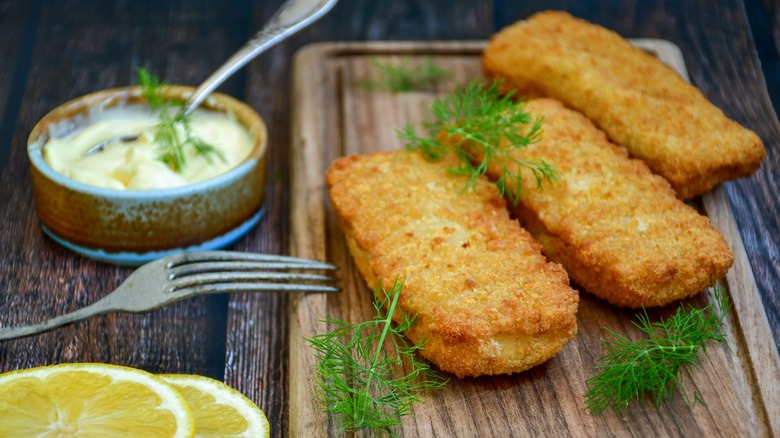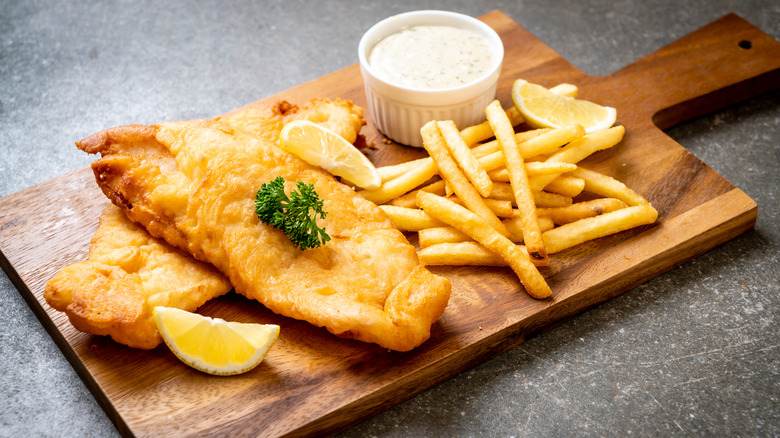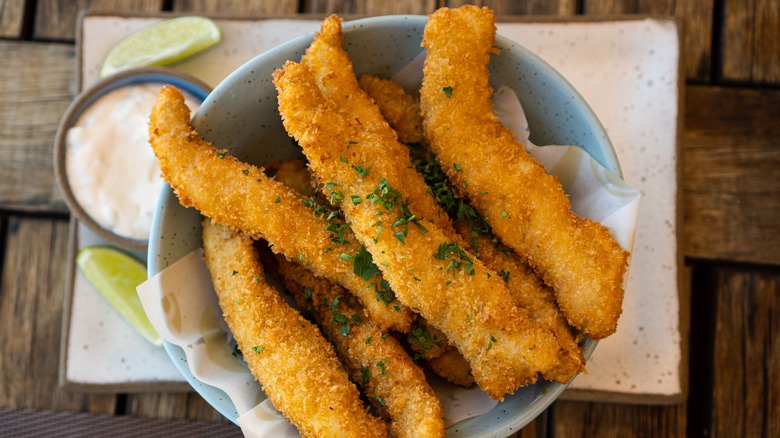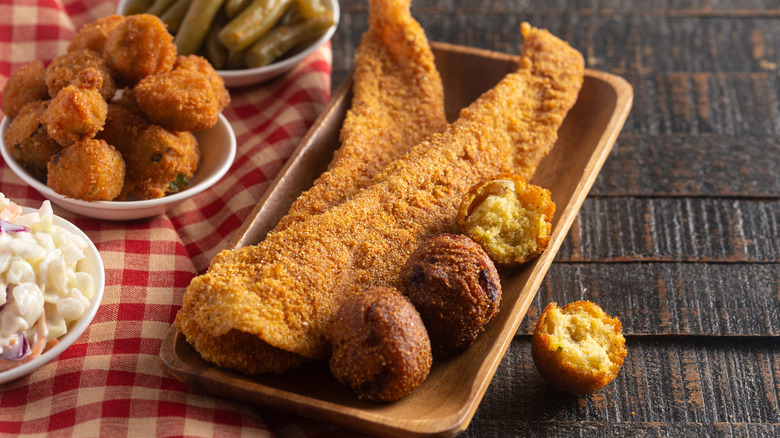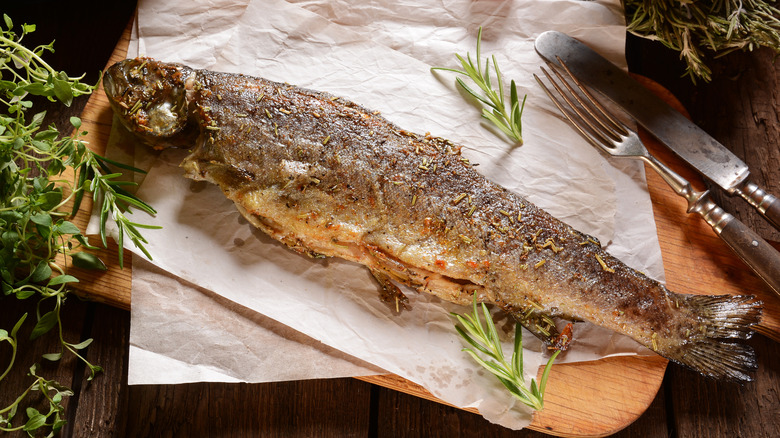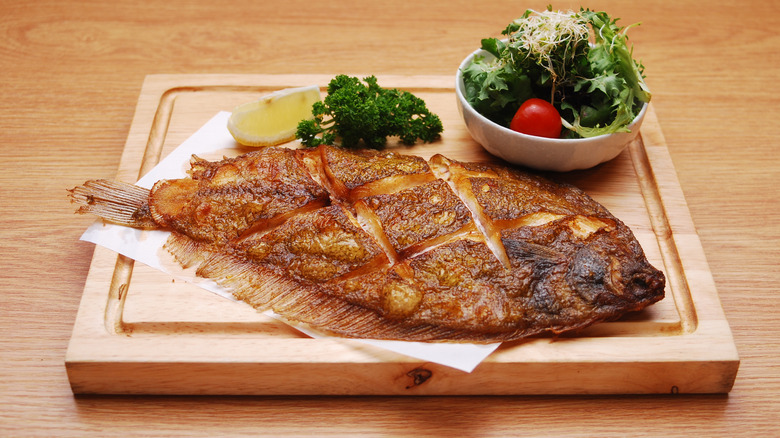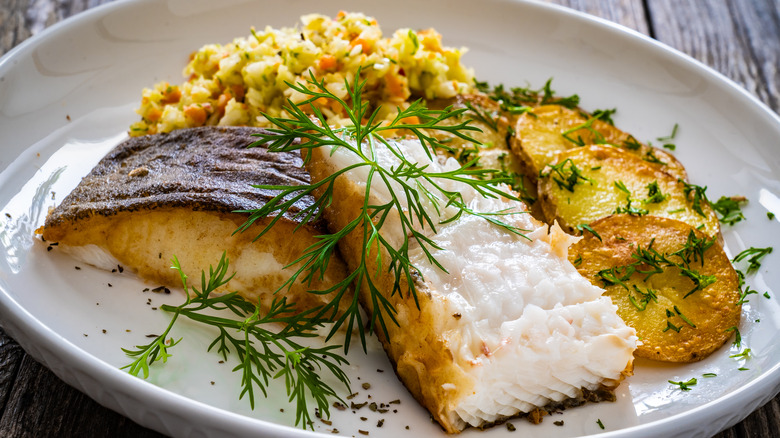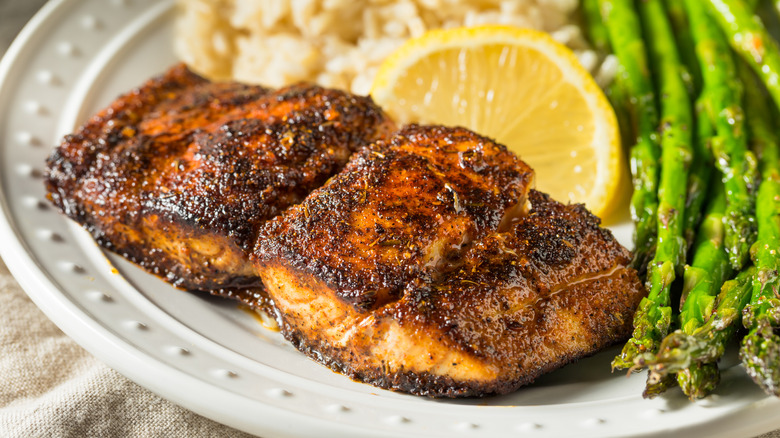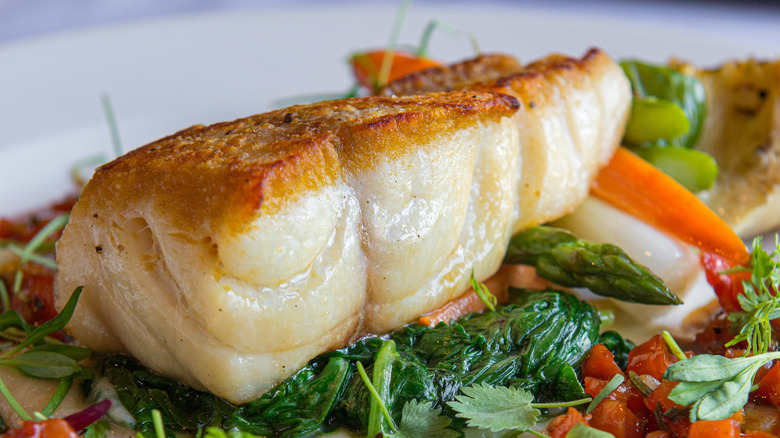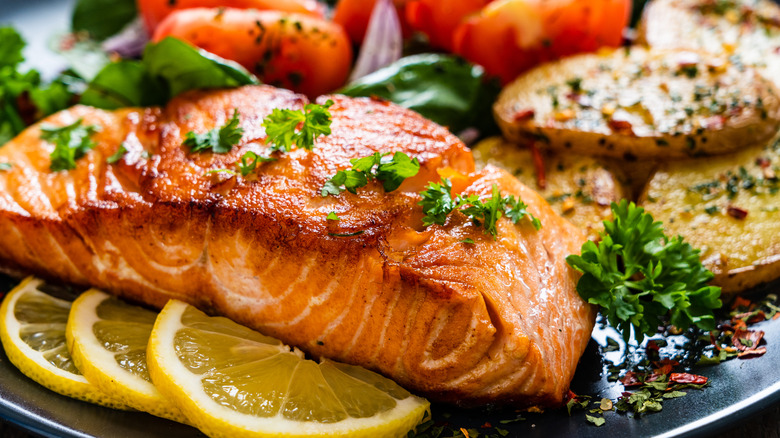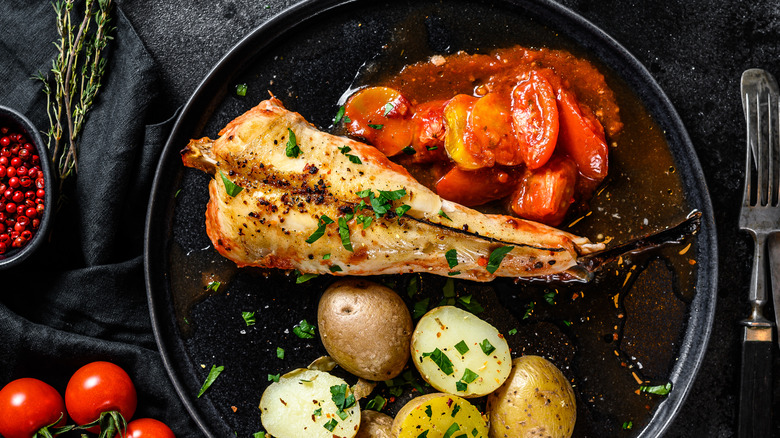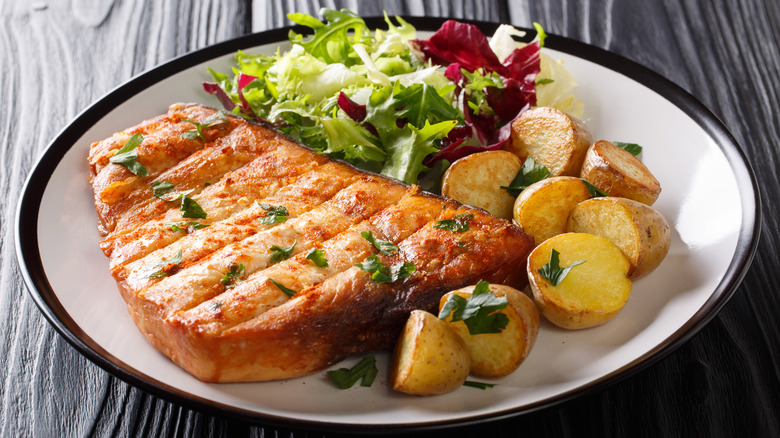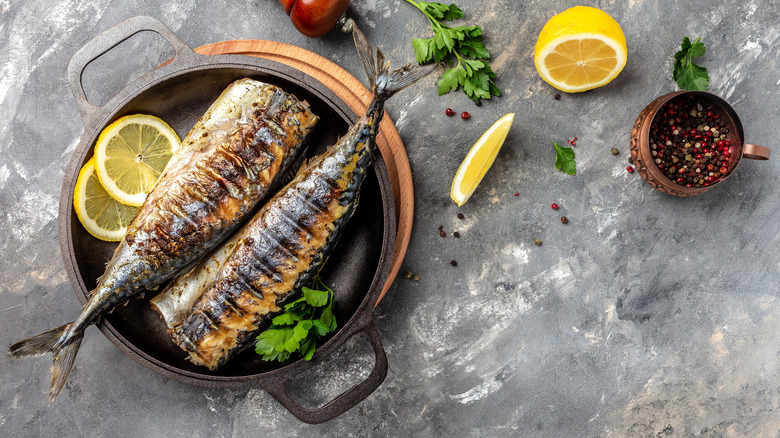The Best And Worst Types Of Fish For Frying
Are you looking for a cooking technique that can enhance the sweet, delicate natural flavors of fresh fish while also creating a delectable crispy crunch to wrap all those flavors in? Then look no further! Whether you're sautéing fish filets in butter or tossing up some fish and chips in a deep fryer, frying is one of the greatest cooking techniques around for making an incredible fish meal. It's a technique that can make your taste buds sing, please a hungry family, and even impress a large gathering.
But before you head to your local fishmonger to order up the catch of the day, keep in mind that not every delicious fresh fish you can buy makes for a delicious fried fish. While the high heat of frying can help to seal in juices for some types of fish, it dries out the natural moistness of others. And while some fish take to batters and breading like...well, like a fish takes to water...others just don't mesh with these frying essentials in the ways we might hope, ending up dry and tough or soft and mushy.
To help you sort the "fry-friendly fish" from those fish in the "no fry zone," we turned to two of the country's leading fish cooking pros for their expert advice. While some fish varieties are very well suited to frying, others are less than ideal.
Best: Haddock
When you consider all the different types of fish out there that are suitable for frying, haddock may be the most quintessential of them all. After all, it is the traditional type of fish used for fish 'n chips in the U.K., notes Rima Kleiner, a registered dietician, fish expert, and blogger at the popular culinary site Dish on Fish.
Haddock originated in the cold waters of the North Atlantic, and it is one of the most widely consumed fish around the globe and has been for centuries. The fish played a key role in the creation of the fishing industry in Norway, Scotland, Iceland, and even in coastal areas like New England and Newfoundland. (It was such an important fish it was even used as a form of currency)
Why the popularity? Haddock is versatile! Its firmness and flaky texture make it great for baking, grilling, poaching, and especially breading and frying. The end result is a dish with an incredible crispy exterior and flaky, white interior that's mild, sweet, and slightly smoky, says Kleiner.
Can't find any haddock at your local supermarket? There have been reported shortages from time to time in recent years. In that case, consider switching to cod as a backup. It has a similar flakey, delicate flavor. And according to Kleiner, since cod has a relatively mild flavor that holds up to cooking rather well, it's a great fish to fry, especially if you plan on coating your fish in breadcrumbs.
Best: Tilapia
This freshwater fish may be widely consumed around the world today, but it's believed to have originated in Africa's Nile River, where the ancient Egyptians considered it sacred and even honored it in their hieroglyphics and other works of art.
Tilapia is hardy and incredibly fast-growing, and it can reach up to 10 pounds in size. They are also now considered to be one of our most sustainable types of fish and are farmed in many parts of the world, including Asia and North and South America.
According to Kleiner, tilapia is suited to both deep drying and pan frying. It has a mild, delicate flavor that complements herbs and citrus flavors. However, it's important to heat the pan properly; otherwise, it can stick.
Shawn Matijevich, lead chef of online culinary arts & food operations at the famed Institute of Culinary Education, also considers tilapia one of his favorite fish for frying. But like Kleiner, he also recommends a bit of caution when cooking. Since the fish is quite lean, it can be easily overcooked, so additional caution should be exercised.
Similar to other white fish, such as haddock, tilapia's firm texture makes it an easy fish to serve as a filet. But it can also be cut into smaller chunks or nuggets, making it an ideal option for fish tacos or sandwiches.
Best: Catfish
Catfish is a Cajun classic, and nothing exemplifies Southern cooking more than a big plate of catfish paired with coleslaw, hushpuppies, baked beans, and collard greens. Although the fish can sometimes be grilled or baked, both of our experts agree frying is the cooking method that is most adept at bringing out its unique flavor qualities.
Catfish has a mild, sweet taste that is often viewed as a cross between chicken and pork. Catfish filets are typically coated in a seasoned cornmeal mixture and then deep-fried until crispy and golden brown. This method of preparation gives the fish a delicious, crunchy exterior and a tender, flavorful interior.
Because the fish often live in muddy riverbanks, Matijevich does caution that it tends to have a strong, earthy flavor that may not be suited to everyone's tastes. However, most chefs counter that problem by soaking catfish filets in milk or buttermilk before frying, which is a process that generally helps to neutralize any unwanted tastes.
For the best possible catfish dinner, buy the freshest catfish available, and always add it to oil that is already hot to ensure a crispy exterior and a moist, tender interior, and most importantly, never overcrowd your pan. Frying catfish in small batches ensures that each piece has room to cook evenly.
Best: Trout
Trout is the ultimate game fish, and sportsmen across the U.S. flock to picturesque lakes and rivers, and streams year-round in an attempt to catch one of the more than a dozen different types of trout found naturally throughout the cold, clear waters of the Northern Hemisphere. Whether it's the beautiful rainbow trout, the sleek brown trout, or the exotic-looking rainbow trout, all members of the trout family are prized for their firm, meaty flesh, and delicate flavor.
Like salmon (which it is related to), trout is a versatile fish that can be prepared deliciously in a number of different ways. Some like it grilled, others opt for broiling, and many chefs like to poach the trout they cook. But it's also incredible when fried, according to Kleiner. Trout is a thinner species of fish: It's perfect for frying, and it is perfectly suited to a nutty almond or walnut coating.
Season your fish well with salt and pepper, and don't be afraid to add seasonings such as garlic, lemon, or herbs, depending on your taste preferences. Freshly fried trout pairs perfectly with grilled vegetables such as asparagus, carrots, broccoli, or even a fresh salad. And if you're feeling a little indulgent, a light and crisp white wine such as Pinot Grigio or Sauvignon Blanc ideally complements the delicate flavor of freshly cooked trout.
Best: Flounder
In the Disney cartoons, The Little Mermaid's friend Flounder is an adorable yellow and blue bundle of energy. But cute is far from the first word you'd use to describe an actual flounder. Flounder, known as flatfish, are broad, prehistoric-looking asymmetrical creatures with the unique distinction of having both eyes on the same side of their body. These bottom-dwelling fish are capable of reaching up to two feet in length and weighing more than 6 pounds, and they tend to be found in shallow coastal waters around the world.
They're a unique and fascinating fish, and also one of the most delicious and satisfying fish you are ever likely to try. They're also ideal for cast-iron skillets and deep fryers alike! According to Matijevich, the delicate flavor and the muscle structure of flounder make it excellent for frying
Kleiner agrees, noting that the mild and meaty texture is perfect for frying with a bread or cornmeal coating. Lemon, butter, and herbs like dill, parsley, and thyme tend to best compliment flounder's exquisite flavor. Add these herbs to your freshly cooked fish as a garnish, put them in a sauce, or mix them with tartar sauce to create the perfect fried fish bite.
Best: Halibut
Like flounder, halibut is another type of flatfish that is native to the Northern regions of the Pacific and Atlantic Oceans. (The name "halibut" comes from the Old English language, with "hali" meaning "holy," since the fish was typically eaten on "holy" days, and "butt" literally translating to "flat fish."
Halibut is a massive creature that can grow to more than 8 feet long and weigh over 500 pounds. This bottom-dweller spends its time dining on other seafood, including smaller fish, shrimp, and crustaceans. Halibut is highly prized in restaurants and fish markets alike for its mild, sweet flavor, firm and flaky texture, and low oil content. This also makes it an incredibly lean protein loved by health food fans and bodybuilders alike.
According to Kleiner, Halibut is meaty and delicate, and it's perfect for pan frying. It complements ingredients like parsley and other fruit flavors. Matijevich also likes his halibut fried. "This is a great fish to fry in a beer batter," he says. "It typically takes a long time to fry, so a thicker batter is warranted."
The end result is a plate of food that's delightfully crispy and crunchy on the outside and tender and juicy with subtle sweetness and nutty undertones on the inside. Grab a light and refreshing lager or pilsner to wash it all down, and you may just have the perfect meal!
Best: Mahi-mahi
While many of the fish that are ideal for frying live in the world's colder Northern waters, Mahi-mahi is a different sort of fish altogether. Mahi-mahi is a beautiful iridescent green fish with a toothy, fierce-looking underbite, and it hails from the tropical and subtropical waters of the Pacific, Indian, and Atlantic Oceans.
It has a long, slender body and blunt head, and it's capable of growing to sizes of nearly seven feet and close to 100 pounds. The Polynesians had it right when they named this ocean beast: The name "mahimahi" literally means "strong-strong" in Hawaiian! Mahi-mahi is commonly used in ceviche, sushi, and other raw fish dishes, and it is also great grilled, baked, sautéed, and especially fried.
Kleiner recommends pairing freshly fried Mahi-mahi with cilantro and lime flavors to really bring out its delicate, sweet flavor. Use either these ingredients to create a decadent dipping sauce or try adding them to your breading before you fry! But go easy. As with other lean fish, Matijevich urges care when cooking as Mahi-mahi can easily dry out, leading to an overly fishy flavor.
Another plus for the Mahi-mahi? As with many of the other types of fish, it's a nutritional powerhouse that's rich in protein, vitamins, and minerals and relatively low in fat and calories. In other words, Mahi-mahi is a win-win!
Best: Grouper
There's a reason the grouper fish, which averages in at 7 feet long and 400-plus pounds, looks like some sort of prehistoric monster: It is! Scientists have found fossils of members of the grouper family of fish dating back more than 50 million years: That's well into the age of the dinosaurs. Grouper is believed to have originated in the Indo-Pacific region, but today, they can be found in the Atlantic, Pacific, and Indian Oceans. Grouper is another fish that is loved for its delicate, nutty flavor and firm, meaty texture, and it can be grilled, baked, broiled, and poached. According to Matijevich, this fish goes well with any kind of batter.
To prepare it, start out as you would with any fish you are frying and dredge the filet in flour that has been seasoned with salt, black pepper, garlic powder, and other herbs and spices of your choice. Then dip the fish filet in your batter. Beer batter works great for grouper too. You can also go the panko route in place of batter. Take your dredged grouper, dip the filet into beaten eggs, and then coat it in seasoned Japanese panko crumbs. To kick either creation up a notch, add fresh chopped herbs, grated Parmesan cheese, or a splash of hot sauce or Worcestershire sauce. Whatever option you choose, you should end up with fish that's crispy and golden on the outside and moist and buttery smooth on the inside.
Worst: Salmon
While our experts say there is no fish out there you absolutely should never fry, there are some options that work better for certain techniques than others based on their taste, texture, or a combination of the two. For example, salmon is an incredible fish and also one of the most popular types of fish not just in America but around the world. So why shouldn't you fry it?
You can, our experts say, but it just generally tastes better when it's cooked in other ways. Matijevich cautions that salmon does not do very well with batters. Kleiner shares his concern, saying that thick varieties of fish, such as salmon, will dry out when fried, while thinner types of fish tend to hold up well to the frying process.
Another problem is that salmon has a very high oil content. This natural oiliness can make it more difficult to achieve a crispy, golden exterior when fried. Even worse, that excess oil can also make the fish feel heavy and greasy when fried, which can be a big turn-off for many.
In other words, stick with your salmon on the grill, in your sushi, or even baked or broiled in the oven, and save the batter and deep fryer for a different fish variety better suited to frying. Your taste buds will thank you!
Worst: Monkfish
While the hefty North Atlantic fish known as the monkfish might seem like a good candidate for frying due to its size and meaty texture, it definitely has some traits that also make frying a less-than-ideal method of cooking. For starters, monkfish smells. There's no way around it: The fish has a very strong, pungent odor. And this odor can seep into your oil while frying, making the scent even more potent and also making the flavor of the fish slightly unpleasant.
Monkfish is also known for having a tough, rubbery texture that can be difficult to cook properly, especially for novice chefs. If you do decide to try frying it, try soaking your filets in a salty brine or lemon juice, vinegar, or wine marinade for 30 minutes to an hour before frying. You can also cut the fish into smaller pieces before cooking, which thereby also makes it more tender. Or place the monkfish between two sheets of plastic wrap and pound it with a meat mallet before frying. This will break down the fibers in the fish and make it more tender once it's cooked.
According to Matijevich, while no variety of fish is impossible to fry, tougher types of fish, like monkfish, may require additional prep to attain tenderness. Or, save yourself the trouble and pick a different protein for your next big fish fry.
Worst: Swordfish
Swordfish, with its sword-like snout and massive 10-foot, half-ton weight, is among one of the undisputed kings of the sea. These swift swimming predators (which can reach speeds of up to 60 miles per hour) are a fisherman's dream and are just as popular in restaurants and home kitchens alike, where chefs of all stripes clamor for a good swordfish steak.
But those steaks rarely end up in the deep fryer or frying pan. Instead, most swordfish are either grilled or broiled. The reason? Swordfish dries out very easily and can quickly become tough when cooked incorrectly, so it's a poor match for frying. Matijevich wouldn't fry a swordfish unless it was cut into really small strips and dipped into an airy batter. In addition to drying out quickly, swordfish can also end up tasting very fishy.
As usual, our experts are once again on the same page. According to Kleiner, swordfish, like salmon, is meaty and thick, so it can easily dry out when fried or otherwise cooked incorrectly. Whether you're cooking swordfish, cod, grouper, or snapper, Kleiner suggests keeping a special eye on just how high your frying temperature may climb so that it doesn't overcook easily. That's one of the main reasons fish becomes dry. High heat can result in any fish you are frying tasting subpar.
Worst: Mackerel
Woe is the mackerel. As fish go, it's a beauty. It's around a foot long and weighs in at a respectable 5 to 6 pounds. These schooling fish tend to hang out near the surface of the water throughout the Atlantic. But while they might be small enough and easy enough to catch, no one really wanted them for years because they were considered unclean or too fishy. Oftentimes, mackerel just didn't fit the bill of what consumers were looking to buy.
And while that has changed over the past few decades, and mackerel are more popular than ever, they still have some serious drawbacks if you're looking for a fish to fry. For starters, according to Matijevich, mackerel has a very strong fishy flavor, and frying only makes that strong flavor more pronounced. If you do fry it, he recommends pairing it with a sauce to make the dish more palatable. Capers and horseradish are also good options for matching that strong flavor, Kleiner adds.
Like salmon, mackerel is also a fatty fish with a high oil content, which can make it difficult to fry. This can lead to extra splatter and potential burns when cooking or a plate of food that seems exceedingly greasy and heavy. Finally, mackerel also has a relatively delicate texture. So even if you like the taste and can deal with the oiliness, your filets of fish can easily break or fall apart during frying, ruining your meal: Woe is the mackerel, indeed!
